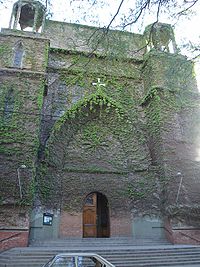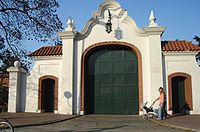
Olivos, Buenos Aires
Encyclopedia
Olivos is an Argentine city in Vicente López Partido
in the Province of Buenos Aires and a suburb within the Greater Buenos Aires
metro area.
Olivos is the site of the official residence of the President of Argentina
(the name of this compound is the Quinta Presidencial de Olivos
) and a relatively exclusive residential area where most heads of households commute to Buenos Aires
, 22 km (14 mi) to the south. The city is bordered on the east by the shores of the Río de la Plata
.

 A well-known stop along the Buenos Aires-Córdoba
A well-known stop along the Buenos Aires-Córdoba
trade route for much of the 18th century, one of the area's first landowners, Domingo de Acassuso, began cultivating olive tree
s around 1720 and the spot was officially named Olivos on 19 February 1770. Much of the area was later purchased by Viceroy Antonio de Olaguer y Feliú
and by a German immigrant
, Hernán Wineberg, who sold a large tract in 1860 for the construction of the Ferrocarril Central Argentino through the area. The 1863 inaugural of the local railway station
, one of Argentina's first, began attracting homeowners drawn by the area's tranquility and convenient access to the rapidly-growing capital and, in 1897, the Church of Jesus of the Olive Trees was consecrated. A 1905 edict subdivided San Isidro Partido
in two, creating the modern Partido de Vicente López and designating Olivos as the seat.
Home to a growing upscale community by 1917, local businessman Rodolfo Negrete founded the city's first clinic and marina and, during the 1920s, the small marina was modernized and the city's streets paved. The opening of National Route 9 in the mid-1930s, west of the city, further accentuated the area's draw as a convenient suburb for Buenos Aires commuters. The city became the focus of national attention in 1941 when, upon the passing of Carlos Villate Olaguer (a great-great-grandson of Viceroy Olaguer y Feliú's), a 35 hectare (88 acre) section of the family's local land was deeded to the national government for use as the president's official residence. Graced by a mansion of an eclectic, Neogothic-inspired style, the main house was commissioned by Miguel José de Azcuénaga in 1851 and designed by renowned local artist and architect Prilidiano Pueyrredón
. The complementing structures for the compound were built in variations on Baroque architecture
.
The residence hosted the Olivos Pact, a political agreement signed on 14 November 1993 between then-President Carlos Menem
and former President Raúl Alfonsín
(head of the main opposition party, the centrist Radical Civic Union
). The pact secured support for constitutional reforms allowing for the re-election of the President well as for the popular election of the Mayor of Buenos Aires, hitherto an appointed post. The city was also witness to the Kheyvis
nightclub fire (20 December 1993), the deadliest such tragedy in Argentina up to that point. Olivos was selected as a stop along the Tren de la Costa
tourist railway upon the line's opening in 1994.
Vicente López Partido
Vicente López is a partido located in the north of Greater Buenos Aires in Buenos Aires Province, Argentina. The capital is Olivos.-Districts:* Carapachay* Florida* La Lucila* Munro* Olivos* Vicente López* Villa Adelina* Villa Martelli...
in the Province of Buenos Aires and a suburb within the Greater Buenos Aires
Greater Buenos Aires
Greater Buenos Aires is the generic denomination to refer to the megalopolis comprising the autonomous city of Buenos Aires and the conurbation around it, over the province of Buenos Aires—namely the adjacent 24 partidos or municipalities—which nonetheless do not constitute a single administrative...
metro area.
Olivos is the site of the official residence of the President of Argentina
President of Argentina
The President of the Argentine Nation , usually known as the President of Argentina, is the head of state of Argentina. Under the national Constitution, the President is also the chief executive of the federal government and Commander-in-Chief of the armed forces.Through Argentine history, the...
(the name of this compound is the Quinta Presidencial de Olivos
Quinta de Olivos
The Quinta de Olivos is an architectural landmark in the north side Buenos Aires suburb of Olivos and the official residence of the President of Argentina.-Overview:...
) and a relatively exclusive residential area where most heads of households commute to Buenos Aires
Buenos Aires
Buenos Aires is the capital and largest city of Argentina, and the second-largest metropolitan area in South America, after São Paulo. It is located on the western shore of the estuary of the Río de la Plata, on the southeastern coast of the South American continent...
, 22 km (14 mi) to the south. The city is bordered on the east by the shores of the Río de la Plata
Río de la Plata
The Río de la Plata —sometimes rendered River Plate in British English and the Commonwealth, and occasionally rendered [La] Plata River in other English-speaking countries—is the river and estuary formed by the confluence of the Uruguay River and the Paraná River on the border between Argentina and...
.
History


Córdoba, Argentina
Córdoba is a city located near the geographical center of Argentina, in the foothills of the Sierras Chicas on the Suquía River, about northwest of Buenos Aires. It is the capital of Córdoba Province. Córdoba is the second-largest city in Argentina after the federal capital Buenos Aires, with...
trade route for much of the 18th century, one of the area's first landowners, Domingo de Acassuso, began cultivating olive tree
Olive Tree
The Olive Tree was a denomination used for several successive centre-left Italian political coalitions from 1995 to 2007.The historical leader and ideologue of these coalitions was Romano Prodi, Professor of Economics and former leftist Christian Democrat, who invented the name and the symbol of...
s around 1720 and the spot was officially named Olivos on 19 February 1770. Much of the area was later purchased by Viceroy Antonio de Olaguer y Feliú
Antonio de Olaguer y Feliú
Antonio de Olaguer y Feliú was a Spanish soldier and politician who spent most of his career in South America.Born in Villafranca del Bierzo, León, Olaguer was sent to Buenos Aires as a military specialist during the governorship of Pedro de Cevallos. He took part in the siege of Colonia del...
and by a German immigrant
German settlement in Argentina
German Argentines are Argentines of German descent. The term "German" usually refers to Ethnic Germans who immigrated to Argentina from Germany, Austria, France, Hungary, Poland, Romania, Russia, Switzerland, former Yugoslavia and elsewhere in Europe...
, Hernán Wineberg, who sold a large tract in 1860 for the construction of the Ferrocarril Central Argentino through the area. The 1863 inaugural of the local railway station
Rail transport in Argentina
The Argentine railway network comprised of track at the end of the Second World War and was, in its time, one of the most extensive and prosperous in South America. However, with the increase in highway construction, there followed a sharp decline in railway profitability, leading to the break-up...
, one of Argentina's first, began attracting homeowners drawn by the area's tranquility and convenient access to the rapidly-growing capital and, in 1897, the Church of Jesus of the Olive Trees was consecrated. A 1905 edict subdivided San Isidro Partido
San Isidro Partido
San Isidro is a partido of Buenos Aires Province, Argentina found in the north of Greater Buenos Aires. Its capital is the city of San Isidro. It is from the city of Buenos Aires....
in two, creating the modern Partido de Vicente López and designating Olivos as the seat.
Home to a growing upscale community by 1917, local businessman Rodolfo Negrete founded the city's first clinic and marina and, during the 1920s, the small marina was modernized and the city's streets paved. The opening of National Route 9 in the mid-1930s, west of the city, further accentuated the area's draw as a convenient suburb for Buenos Aires commuters. The city became the focus of national attention in 1941 when, upon the passing of Carlos Villate Olaguer (a great-great-grandson of Viceroy Olaguer y Feliú's), a 35 hectare (88 acre) section of the family's local land was deeded to the national government for use as the president's official residence. Graced by a mansion of an eclectic, Neogothic-inspired style, the main house was commissioned by Miguel José de Azcuénaga in 1851 and designed by renowned local artist and architect Prilidiano Pueyrredón
Prilidiano Pueyrredón
Prilidiano Pueyrredón was an Argentine painter, architect, and engineer. As one of the country's first prominent painters, he was known for his costumbrist sensibility and preference for everyday themes....
. The complementing structures for the compound were built in variations on Baroque architecture
Baroque architecture
Baroque architecture is a term used to describe the building style of the Baroque era, begun in late sixteenth century Italy, that took the Roman vocabulary of Renaissance architecture and used it in a new rhetorical and theatrical fashion, often to express the triumph of the Catholic Church and...
.
The residence hosted the Olivos Pact, a political agreement signed on 14 November 1993 between then-President Carlos Menem
Carlos Menem
Carlos Saúl Menem is an Argentine politician who was President of Argentina from 1989 to 1999. He is currently an Argentine National Senator for La Rioja Province.-Early life:...
and former President Raúl Alfonsín
Raúl Alfonsín
Raúl Ricardo Alfonsín was an Argentine lawyer, politician and statesman, who served as the President of Argentina from December 10, 1983, to July 8, 1989. Alfonsín was the first democratically-elected president of Argentina following the military government known as the National Reorganization...
(head of the main opposition party, the centrist Radical Civic Union
Radical Civic Union
The Radical Civic Union is a political party in Argentina. The party's positions on issues range from liberal to social democratic. The UCR is a member of the Socialist International. Founded in 1891 by radical liberals, it is the oldest political party active in Argentina...
). The pact secured support for constitutional reforms allowing for the re-election of the President well as for the popular election of the Mayor of Buenos Aires, hitherto an appointed post. The city was also witness to the Kheyvis
Kheyvis
Kheyvis was a nightclub in Olivos, Buenos Aires, Argentina. On 20 December 1993, a fire in the club caused the deaths of 17 teenagers in a graduation party for the La Salle College...
nightclub fire (20 December 1993), the deadliest such tragedy in Argentina up to that point. Olivos was selected as a stop along the Tren de la Costa
Tren de la Costa
Tren de la Costa is a suburban , 11-station light rail line in Greater Buenos Aires, between Maipú Avenue station in the northern suburb of Olivos and Delta station in Tigre, on the Río de la Plata...
tourist railway upon the line's opening in 1994.

